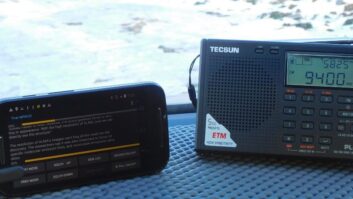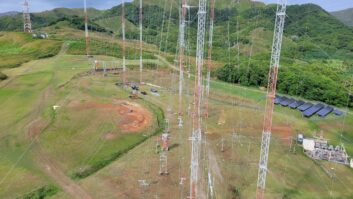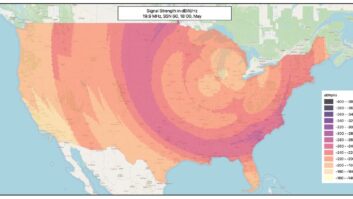OTTAWA — On Jan. 31, state-owned Australian Broadcasting Corp. shut down its shortwave radio transmitters; ending both international broadcasts of Radio Australia and the ABC’s domestic service in Australia’s Northern Territory. The transmitters were located at ABC broadcasting facilities at Katherine, Tennant Creek, and Roe Creek (Alice Springs).
According to the ABC news release that announced the shutdown on Dec. 6 — less than two months before it took place — “The move is in line with the national broadcaster’s commitment to dispense with outdated technology and to expand its digital content offerings including DAB+ digital radio, online and mobile services, together with FM services for international audiences.”
The ABC is not alone in retreating from shortwave radio transmissions. As reported in the RWI August 2016 article, “The Evolution of Shortwave Radio” (https://www.radioworld.com/digital-radio/0014/the-evolution-of-shortwave-radio/338422), the BBC World Service and Voice of America have substantially reduced their international shortwave broadcasts, while Radio Canada International, Radio Netherlands, Swiss Radio International, and Radio Sweden International ceased shortwave broadcasts altogether.





The ABC’s maps of AM/FM coverage as listed in its “ABC Remote Radio” document.
Credit: ABC
The majority of ABC audiences in the Northern Territory currently access ABC services via AM and FM and all ABC radio and digital radio services are available on the Viewer Access Satellite Television (VAST) satellite service.” RWI requested an in-person interview with ABC for this article, but the request was denied.
DISACCORD
Many listeners within the Northern Territory disagree with the ABC’s assertion that shortwave is no longer necessary.
The reason is that AM and FM services do not cover the entire area as shortwave did. Meanwhile, although the Australian government’s VAST satellite TV service is free to viewers who cannot access over-the-air digital television broadcasts, however, the receiving equipment costs hundreds of dollars more than a simple SW radio receiver — and is not practical for mobile Northern Australians who work outdoors. This impracticality was made clear in a Philip Somerville cartoon published by the ABC Friends Western Australia listener group. It shows a cowboy with a satellite dish mounted on his not-impressed horse’s head.
“Mark Crocombe with Thamarrurr Rangers in Wadeye on the territory’s northwest coast said his group would miss listening to ABC programs via shortwave radio while out in the field, and raised concern about access to emergency information,” reported the web site of The Australian newspaper. “Louise Bilato, executive officer with the NT Road Transport Association, said satellite services were inadequately tested on vehicles and could prove too expensive to install. ‘This would appear to be a decision made in haste, without sufficient consultation,’” Bilato said.
There is also concern that the shutdown of ABC’s international Radio Australia service will hurt Asia-Pacific nations who relied on this service as a trustworthy alternative to their own government-controlled media.
“As an example, in April 2009, after military chief Frank Bainimarama was reappointed as interim prime minister of Fiji and subsequently tightened media censorship, ABC increased its shortwave radio services targeting the region,” said Thomas Witherspoon, editor of the SWLing Post.
MONEY

A Phil Somerville editorial cartoon by the ABC Friends Western Australia listener group illustrates how many Australians feel about the ABC’s claim that satellite TV can replace shortwave radio in Northern Australia.
Credit: ABC Friends WA
Money is the reason ABC decided to shut down its shortwave service to northern Australia and the world. At a time when funding is tight, the corporation decided that “the closure of shortwave radio transmission services will potentially allow for AU$1.9 million to be reinvested in expanded content and services,” said the ABC FAQ that accompanied the Dec. 6 shortwave shutdown announcements. “Part of this reinvestment includes improved FM broadcasting capabilities to some of the regions currently relying on shortwave. Domestically, the costs of transmission via shortwave radio will be reinvested in extending digital radio services into all eight capital cities.”
The ABC decided to reallocate shortwave-related funding because it believed the service didn’t have many listeners anymore. The key word here is “believed”: The corporation has publicly admitted that it did not have any actual audience numbers to base its decision on. According to an ABC news report, Garry Cratt of the SW receiver supplier Tecsun Radio Australia estimates that “5,000 people regularly use a shortwave in Australia and the Pacific to listen to ABC Radio.”
“Due to the nature of the technology and the remote locations of shortwave users, it is very difficult to ascertain with any precision the number of listeners who use the service,” said the ABC. “Expert opinion and observation estimates the number of users of the NT shortwave users to be minimal compared to other broadcast services … There is no available data on audience numbers for the regions affected by the closure of ABC International services.”
The ABC’s position on shortwave listenership does not impress Alex Wake. He is a former ABC journalist who is now teaching journalism at RMIT University in Melbourne.
“The ABC has released very little survey data about who was listening to the shortwave services or where they were located,” said Wake. “It is known that shortwave radio-serviced Australians lived in rural and remote areas particularly in the far north of Queensland and the Northern Territory.”
“In recent years, the shortwave services were also tailored to Melanesian communities in PNG [Papua New Guinea], Solomon Islands and Vanuatu,” Wake continued. “I had a message once from a worker living with villagers on island in the remote islands of Vanuatu telling me that the villagers carefully saved their batteries so they could tune in for news bulletins from Radio Australia. Similarly I’ve had colleagues who were told that indigenous communities in northern Australia had been warned about cyclones (and were able to prepare) because they were able to listen to shortwave radio.”
Also unimpressed by the ABC’s decision to kill shortwave is Tracey Hayes. She is the chief executive of the Northern Territory Cattlemen’s Association; the kind of people who need radio while on the move.
“People that live out in contracting camps or mustering stock camps or outstations, and even a lot of the people who live in the bush on cattle stations, spend probably 100 percent of their waking hours out on the land and have very minimal contact with other human beings,” Hayes told The Guardian newspaper. “You can imagine how isolating that would be without having access to the outside world via radio during the day while you’re out in the workplace. But I don’t think they (the ABC) took that into consideration.”
The ABC shortwave shutdown was decided upon without any consultation with the NTCA or other affected groups, Hayes added. “That in itself in this day and age shows a complete disregard and a level of arrogance that is not acceptable from a government-funded broadcaster,” she told The Guardian.
EMERGENCY COMMUNICATIONS

A panoramic view of the western wall of the Glen Helen Gorge; part of northern Australia’s vast, sparsely populated landscape.
Credit: Toby Hudson via Wiki Commons
In a region where severe weather is a fact of life, the loss of ABC’s far-reaching, cheap-and-simple-to-receive SW service is of real concern to northern Australians and Radio Australia’s former international listeners.
“In Australia, the loss of SW-delivered weather bulletins will not be helpful during the cyclone season for those residents in isolated areas from Darwin to Perth,” said John Galt; noted shortwave listening hobbyist and author of the Shenandoah Shortwave Radio Central blog (http://johngaltfla.com/wordpress/voice-of-galt-shortwave-radio-central/). “Worse, if there is no cellphone service or local broadcast outlets, they will be dependent on receiving news about the Australia via Indonesian and Chinese broadcasters, along with what remains of the BBC Asian services broadcasting out of Singapore.”

CSIRO Livestock Industries’ Belmont Research Station, where they develop tick-resistant cattle for northern Australia.
Credit: CSIRO
“Beyond Australia it is a sad tale,” Galt continued. “Mariners will now have to switch to Radio New Zealand’s single shortwave transmitting outlet for news when they are within range of its lower powered broadcasts. The islanders of Polynesia and Micronesia, along with residents outside of the major cities in Papua New Guinea and Indonesia, are now also dependent on any news about Australia filtered from China, Japan, the limited BBC transmissions, and Radio New Zealand.”
The ABC has responded to such concerns by offering a range of SW alternatives. “During fire and flood activity, audiences could access the ABC’s emergency broadcast through AM, as well as content from the relevant emergency body,” said the Dec. 6 ABC FAQ. “Cyclone activity is usually coastal in nature, in which case audiences are covered by FM, maritime distress frequencies, and the ABC’s close working relationship with northern indigenous broadcasters — particularly in times of emergency broadcasting.”
“Many four-wheel drive and long distance truck drivers are equipped with comprehensive long-range radio and/or satellite phones — both of which are two-way in nature and therefore more useful in an emergency than SW’s one-way path,” the ABC FAQ added. “To prepare for emergency situations, audiences are encouraged to establish safety satellite phones and tracking devices. Impacted truck drivers and travel enthusiasts (for RVs and campervans) are encouraged to access local radio via VAST six-month licenses.”
To further address the concerns of those now without shortwave service, the ABC has also published a 13-page guide to alternative services entitled “ABC Remote Radio.” Available at http://about.abc.net.au/wp-content/uploads/2017/02/Jan2017_ABC-Remote-Radio-Access-Guide.pdf, the guide includes satellite imagery-based coverage maps for the ABC’s AM and FM services; none of which come close to covering the area formerly covered by shortwave.
“Keeping in mind that the ABC’s mandate specifies accessibility to all Australians, their alternatives are not realistic nor accessible for those working and living in the Outback,” said SWLing Post’s Witherspoon. Meanwhile, “The ABC’s plan to donate VAST systems to the Royal Flying Doctor Service and 4WD Radio club bases with the idea that, in regions that now lack news service, emergency and warning messages can be rebroadcast ‘as required’ seems inadequate. In the past, the Northern Territory shortwave service served this function.”
Inadequate or not, the ABC’s shortwave services are now history; leaving northern Australians and the Pacific Islands who used to rely on Radio Australia for lifeline radio to cope as best they can. The closure happened despite the opposition stated above plus objections from some Australian politicians. Now that these shortwave transmitters are dark, it seems unlikely that they ever be turned on again — barring some subsequent disaster that tragically proves how much northern Australia needs shortwave radio.
With the loss of the ABC’s shortwave service, “Emergency service warning will be lost to rural and remote areas, and information will be cut to these people,” concluded Wake. “These are generally people who have little political power in Australia; particularly villagers in remote Melanesian islands. Australia has a responsibility as a good neighbor to provide these services.”
James Careless reports on the industry for Radio World from Ottawa, Ontario.











